(11 am. – promoted by ek hornbeck)
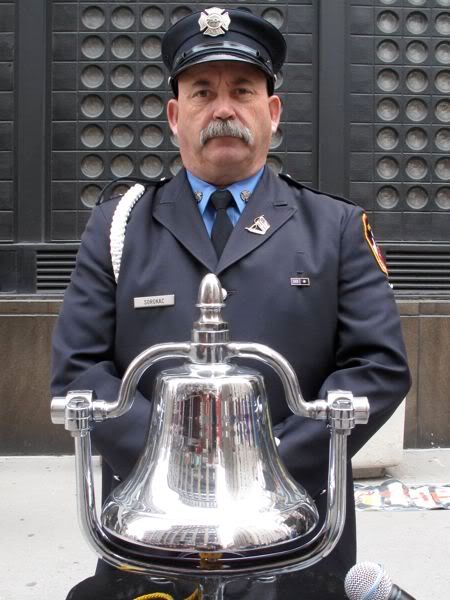
Cross-posted at DailyKos.
At 11:30 yesterday morning on the corner of Greene St. and Washington Pl. I met Firefighter James M. Sorokac for the first time. I’d never met him before but being the keeper of “The Last Alarm” and a member of the of the FDNY ceremonial unit, his face was far too familiar to me.
In the shadow of the Asch Building he explained that the bell that is rang for the fallen dates back to a time when there was one bell at every NYC fire house. He told me the story of the four fives. When firehouses would communicate to each other across the city by ringing five times in a series of four the message that “a brother has fallen in the line of duty.”
Today that bell is rang once by a white gloved firefighter at funerals and memorial services.
Yesterday Firefighter James M. Sorokac rang that bell 146 times.
On March 25,1911 during The Triangle Factory Fire 146 lives were lost. Mostly women and some children, many jumped to their deaths to escape the flames because the exit doors were locked. Those doors were locked to keep the young immigrant workers in and to keep union organizers out. Some were burned alive and many perished from smoke inhalation behind those locked doors.
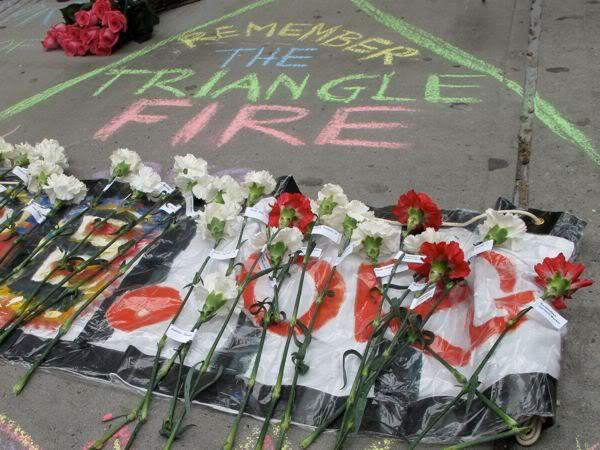
At 11:30 yesterday morning there was a small gathering to remember those many lives lost there 99 years ago. Yesterday’s memorial was hosted by what is left of New York’s once mighty garment workers union. Workers United tried to publicize the remembrance the worst factory fire in city history but in a city where the labor movement seems to be coming to a close, few could find the time to remember.

Some relatives of the victims, representatives from the FDNY, one government official, a few union officials, many teachers and public school students stood below The Asch Building to remember. The building that once had the top three floors occupied by the Triangle Shirtwaist Factory still stands as a national historic landmark.
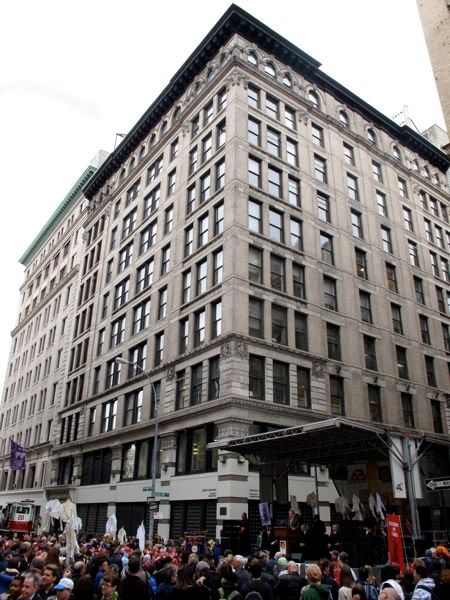
Today that landmark is remembered by many as a sign of progress and union advancement. A government hostile to unions and ignoring the call of the newly formed I.L.G.W.U. for worker safety was all out of excuses when the sidewalks were crowded with the dead bodies of immigrant women.
Witnesses described their bodies hitting the pavement as a steady, deadly drumbeat.
The tragedy was remembered this week in How regulation came to be: The Triangle Shirtwaist Fire. Regulations did come to New York but these American immigrants came to say that “nothing has changed.” They are immigrant workers and after so many dying recently in such a similar circumstance in Bangladesh for clothing that is sold in New York City, they can’t see the progress that so many speak about.

There was a reminder of the present day situation here in the United States by an organizer from Workers United. I think here name was Anna Maria Costa but she told the story of Eleazar Torres-Gomez, a story that was told by TomP at Dailykos back in 2007.

Ms. Costa told the story as a reminder that while an industry can move the manufacture of clothing to far away lands where Americans don’t have to think about “sweat shops” and the abuse of workers they still need to wash clothing here. The mistreatment can still be found in the sad story of Eleazar Torres-Gomez. The wide spread hatred of organizing Cintas that was spread by the company, prevented the industrial laundry from organizing and giving workers a say in their own safety. One year after the death of Eleazar Torres-Gomez, while many politicians had much to say and OSHA investigated this one high profile death, little had been done.
Here is a photo of some of the children who were at the service listening to the story of Eleazar Torres-Gomez who was survived by his wife, Amalia, and their four children: Emmanuel, 25, Nestor 24, Edgar, 14 and Angel, 8.

Yesterday was not a political rally. There was very little politics during the memorial service but those stories were told in memory of those 146 who died there.
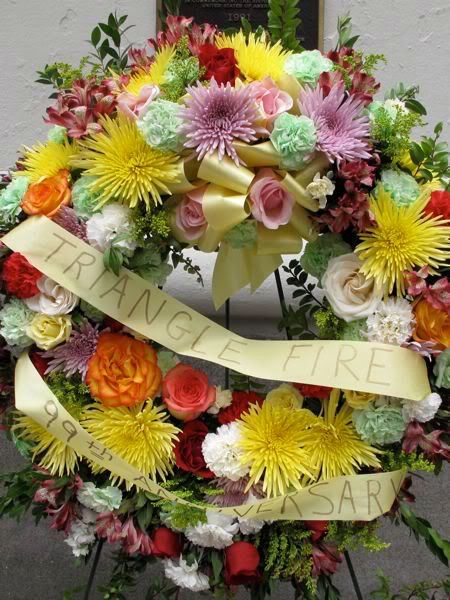
In many ways the day was about educating our children. The morning began with the singing of Annie Lanzillotto for children that had come from surrounding public schools.

Then there was a sing along of some old folk songs for some new ears.

The speeches began when Bruce Raynor stepped up to the lectern to talk about the lives lost and the importance of Worker’s United.

Bruce Raynor introduced Rabbi Michael E. Feinberg, the Executive Director of the Greater New York Labor-Religion Coalition.

After a few words about the victims there was a moment of silence.



Following the Rabbi was Jack Ahern, the new head of the city’s Central Labor Council that is going through difficult times since so many members of city government think union givebacks are the only answer to the fiscal crises. Mr. Ahern did not discuss city workers maintaining living standards but spoke of the horrors of such a grim day in New York City history. He thanked the people for remembering and was one of many people yesterday to use the quote.
“Those Who Forget the Lessons of History Are Doomed To Repeat It.”
The city’s new fire commissioner, Sal Cassano, was there to talk about fire safety. There was much participation from the FDNY. “Ladder 20” was there for a demonstration along with their dalmatian who answers to the name “20.”
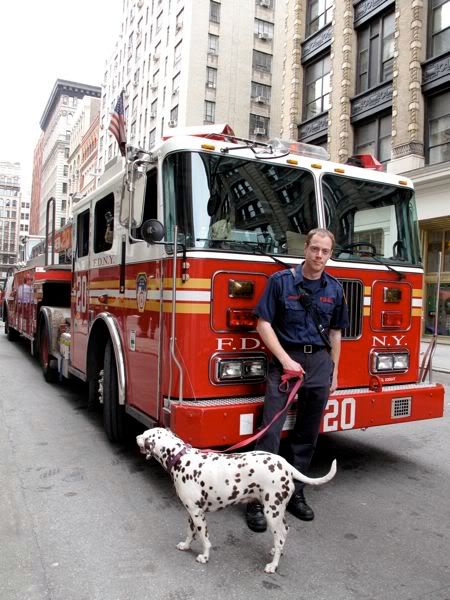
And free smoke detectors batteries were handed out along with fire safety information.
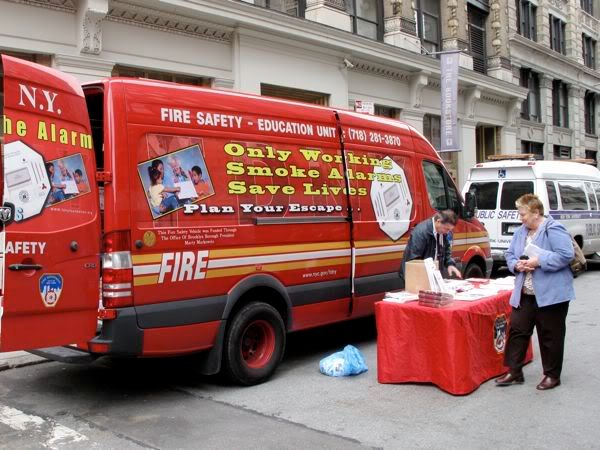
The new city comptroller, John Liu spoke of progress ahead, keeping eye on worker safety and an eye out for worker abuse.
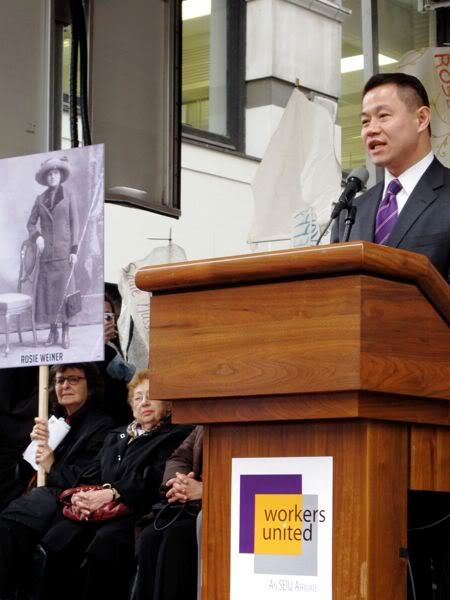
The most powerful of the public speakers was the new leader of the largest union in New York City. Last year I read a great story called Meet Mulgrew, the new power broker you probably don’t know. Michael Mulgrew as the new head of the United Federation of Teachers may also face tough times ahead with a federal government and a New York City mayor that thinks they has found the answer to the nation’s education problems in the hiring of non-union teachers. But like he told the New York Times, “I’m not the kind of person you want to ignore.”

Michael Mulgrew might be a powerful union leader but he showed what his number one priority is when he stepped up to the microphone. He spoke to the students and only the students. First a little lighthearted comedy that got the kids involved. He called out “Are there any students here from P.S.168?” and a some of the children called out “Yea!” Then he asked “Are there any students here from P.S.361?” and all of the students shouted back “No!”
Mr. Mlugrew taught a lesson about decency and watching out for others. He talked about what we learned for such a tragic event. He stressed over and and over that this day to remember the fallen is a day to learn something very important and the lesson he repeated over and over to the students was;
“We always have to raise our voice when we see something wrong.”
Michael Mulgrew was the most powerful of public speakers but the most compelling story came from someone who does not often speak in public, a descendant of one of the 146 that died 99 years ago, a woman who should have known her grandaunt Rose Wiener.

It was good that the young students were taken away to participate in the next stage of the ceremony when this woman told here gut wrenching story of pain suffering and guilt. I was not something children should not hear.
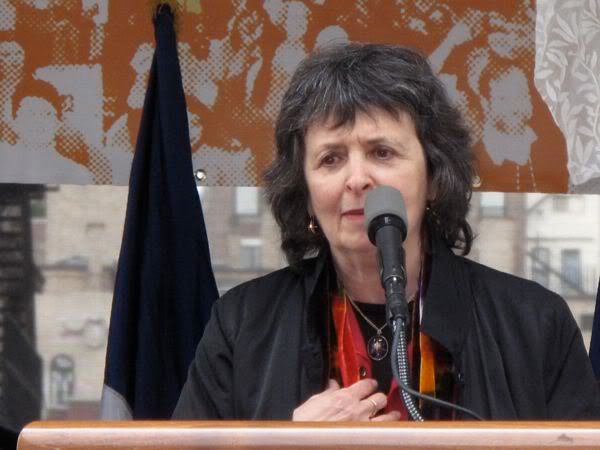
This woman could tell the story of pain and suffering like no other because in addition to losing someone, she also had a relative who survived the Triangle Shirtwaist Fire. A painful story that was told from her memory of hearing from the grandaunt she did know. Rosie Wiener’s sister Katie was one of the young workers who made it out alive and told her family of the horrors for many years. Everything from the the panic, inability to breath and certain death of an inescapable fire followed by the joy of getting out with her life. Years of the nightmares that Katie had, the guilt that she got out without her sister. She spoke of the outrage of when it was learned that the two owners of the factory were acquitted from manslaughter charges and remembered Katie repeating “Not guilty, how could they be not guilty?”
After hearing what the fire must have been like for so many young women, the solemn crowd watched as “Ladder 20” demonstrated how high a fire department ladder could go in 1911. Then we walked over to watch the children pay their respects.

It really was all about the children. Waiting in line each child received one white carnation.
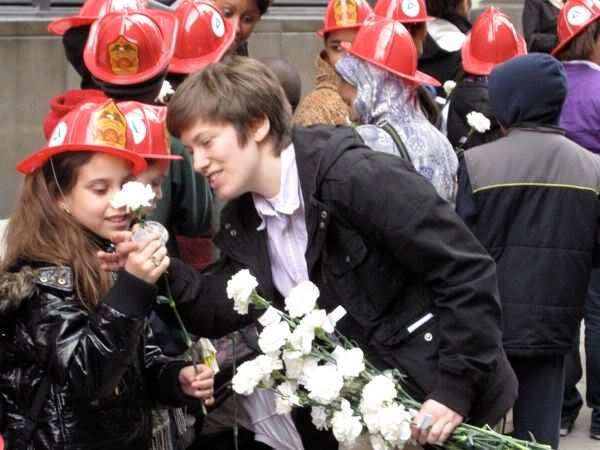

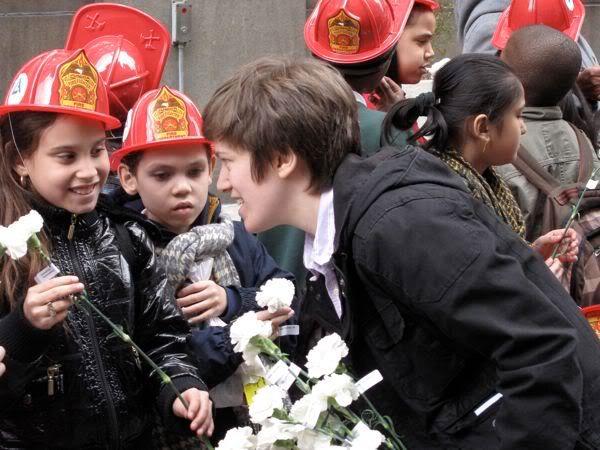
Then both students and relatives of the fallen read the name of one victim as Firefighter James M. Sorokac rang the bell.

After saying the names of the dead a carnation was placed on the sidewalk.



The red carnations were left by the immigrant workers that honored the recent Bangladeshi deaths where the tags just had “Bangladesh Garment Worker” written on the paper. There was twenty-one Bangladeshi carnations.

Each of the white carnations had a name and age except one. One student said something very disturbing and on that tag was written “Unidentified Garment Worker.” You can view all of the names here on a old list but as I looked yesterday it seemed like the dominant age was seventeen and the eldest victim was thirty-three.
In the tragedy that inspired great Americans like Clara Lemlich Shavelson there was once progress to be found in the aftermath;
Frances Perkins was secretary of labor for the 12 years of Franklin D. Roosevelt’s presidency and the first woman to hold a Cabinet post. She brought to her office a deep commitment to improving the lives of workers and creating a legitimate role for labor unions in American society, succeeding admirably on both counts. Always a consummate politician, Perkins profoundly influenced the political agenda of her day, moving it closer to the values she embraced: economic justice and security for all Americans.
One of the pivotal experiences of her political life occurred in 1911, when she watched helplessly as 146 workers, most of them young women, died in the Triangle Shirtwaist fire. Many, she remembered, clasped their hands in prayer before leaping to their deaths from the upper-floor windows of a tenement building that lacked fire escapes. It was, as Perkins later explained, “seared on my mind as well as my heart-a never-to-be-forgotten reminder of why I had to spend my life fighting conditions that could permit such a tragedy.”
But FDR was a long time ago, unions have been shrinking for may years, wages have been stagnate for almost as long and today Americans can’t even get a quorum in National Labor Relations Board.
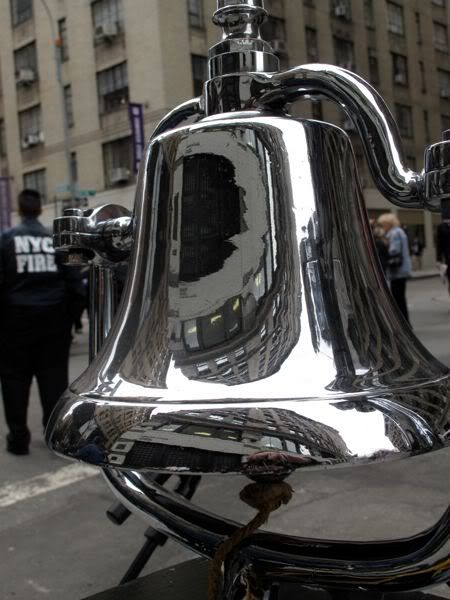

20 comments
Skip to comment form
Author
But the flowers will be there for as long as they last.
Thank you, Eddie. This is a beautiful remembrance of a horrific tragedy, the continued need for fire safety and inspections and a reminder that even today, workers are abused and die around the world for the almighty profit margin.
May the Goddess protect those who perished that day on their journeys through the Summerlands. May their families and friends find Peace.
excellent diary…..
to some of the places that the victims are buried. Many are here on Staten Island.
Author
One of the many reasons I am Union first and democrat second.
Author
I had not actually witnessed the firemen speaking of this but;
What a tragic day for fires in NYC.
this morning at the MT. Richmond Cemetery on Staten Island which is the neighborhood where I grew up. The headstone was for Jacob Bernstein, 28, who died in the fire of smoke inhalation. The original headstone was destroyed and some of the pieces can be found lying on another grave that is missing its headstone.
The Rabbi who spoke was quite eloquent in his sermon speaking of the victims, their families and the impact on safety regulations, unions and the garment industry. He spoke also of death and it inevitability.
After Bouwerie Boy showed us the other headstones some with actual pictures of the victims. He spoke of how he got started researching the grave sites and finding where all the victims of this tragedy were buried, as well as, his mission to mark every one. I hope he can find the time to do another essay. If he does I invited him to post it here.
This is a true mitzva. Bless you, BB
Here is the link to Bouwerie Boy’s diary from Dkos last May, it is a beautiful memorial.
There are pictures of Mt. Richmond Cemetery and the site were most of the graves are. One grave that of Anna Altman, is in the Hebrew National Cemetery a short walk from where we where.
I leaned about the fire after I had discovered the many graves clustered together at the Mt. Richmond site and noticed the date and dedications mentioning the fire. That was back in the 50’s when we would play hide and seek in the older, wooded parts of the cemetery Curious, I went to the library and read about the tragedy. On numerous occasions that I played hookie from school, I would go to the corner to look at the building. It often sent chills up my spine.
What is even more sad and ironic is that years later, on March 25, 1990 at a fire scene in the Bronx, I stood and stared at the bodies of the victims of the “Happy Land” social club fire, again all immigrants. I suddenly realized the significance of the date much later that day. It still sends chills up my back and brings tears to my eyes.